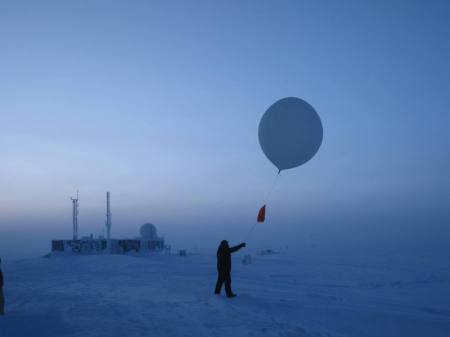Arctic Ground Squirrels

A male arctic ground squirrel emerges from his den in the spring near Alaska's Toolik Field Station after a long and cold hibernation. All photos courtesy Loren Buck
To the naked eye, the abundant arctic ground squirrels near Toolik Field Station, Alaska, simply disappear as the summer slips away. They burrow into nests a meter deep and settle in for a long, cold “sleep” entombed in a virtual ice cave.
Yet their ability to survive such extreme temperatures has long fascinated scientists, and a team of collaborators with NSF funds is studying how hibernating arctic squirrels regulate their temperature and what they use to fuel their bodies (i.e. fats, proteins, carbohydrates).
Using advanced genetic analysis, which will be conducted on captive squirrels in labs at the universities of Fairbanks and Anchorage, the team aims to understand which genes are activated during hibernation in response to temperature changes.
“We already know that hibernating squirrels switch metabolic fuels they draw from based on the ambient temperature,” said Loren Buck, principal investigator and associate professor of biology at the University of Alaska in Anchorage. “Now we want to see how this is accomplished by analyzing which genes are regulated at different stages of hibernation.”
What Genes Tell Us
Made of strands of DNA, genes provide instructions for making proteins, large and complex molecules that perform a number of functions. Proteins provide cell structure, carry out almost all of the cell’s chemical reactions, and act as cell messengers.
Buck’s work with arctic squirrels seeks to understand—at specificity previously not possible because the genetic technology didn’t exist—how the body responds genetically to extreme temperatures.
Buck said the research results could have important biomedical implications. Scientists have long used data on hibernating animals in models for cerebral ischemia (reduced blood flow to the brain), traumatic head injury and hypothermia, and his results could yield important information.
“We have already established that the squirrels switch metabolic fuels in response to changes in ambient temperatures,” said Buck. “Now the question is to understand the mechanism by which they adjust and alter their metabolism.”
In The Lab
In the lab, Buck and his team have a group of squirrels in simulated hibernating conditions with varying temperatures. They monitor the animals’ core body temperatures and the amount of work the hibernating squirrels have to do to keep from freezing.
Not surprisingly, when it isn’t extremely cold, the squirrels work less. For instance, at 2+ degrees C the squirrel body temperature is also about +2 degrees C. However, when the temperature plummets to – 10 degrees C, the animals become “thermogenic” (heat producing) to maintain a core body temp of -2.9 degrees C.
The researchers use genetic analysis known as quantitative real time PCR to identify which reserves (proteins, carbohydrates, etc.) the squirrels rely on at those extreme temperatures.
When the animals are at torpor, a stage of hibernation, their core temperature is the same as the ambient temperature. For instance, when the ground temp is 0 degrees C, so is the squirrels’ core temperature. At this phase, the squirrels rely on fats to fuel their metabolism.
But when ambient temperatures decrease below the level at which squirrels can survive (-2.9 degrees C), the bodies rely on proteins and carbohydrates to keep from freezing.
To analyze the genetic information, researchers euthanize squirrels at various points of their hibernation to study which genes are expressed.
In The Field

Well before hibernation, Buck and a graduate student set up a trapping grid near Toolik Field Station to capture squirrels for lab experiments.
Buck and his team spend time in the field monitoring the squirrels and capturing animals for the labs. They collect data that can be correlated with the genetic experiments.
Temperature loggers have been in place at the squirrel hibernating sites near Toolik since 1993, providing a 17-year picture of ground temperatures. Buck said data from the metabolic study can be correlated with temperature data to study a potential link between environmental temperature and overwinter body mass.
Squirrels as Study Subjects
In addition to the ground temperature loggers, he and his crew have implanted about 100 loggers into squirrels on the North Slope to better understand the biological response to the environment.
“As we collected these data, there was more emphasis on climate change and the need to investigate its impacts on vertebrates,” said Buck. “To get the physiological data it takes a cooperative species with a short enough life span.”
Arctic squirrels are ideal because they don’t move around a lot, are large enough to carry implanted loggers (unlike, say, voles), don’t migrate out of the Arctic when conditions get bad, and are easy to recapture, which allows scientists to retrieve almost 80 percent of the data loggers each year.

Lab members Oivind Toien, Robert Fridinger, and Fanziska Kohl take a break after placing a telemetry receiving station to track tagged squirrels near Toolik Field Station.
Interdisciplinary Studies
Finally, this National Science Foundation-supported research provides an opportunity to train undergraduate and graduate students and post-doctoral fellows in arctic biology and climate change biology, said Buck. Many of his graduate students would be unlikely to leave the lab bench in normal conditions.
However their ventures into the field provide them with more experience and a better understanding of climate science, he said. This insight has been emphasized recently among universities and the NSF in an effort to coordinate research efforts with academics who have a variety of skills.
“The researchers of tomorrow must be far more interdisciplinary in scope, and these types of research projects provide great opportunities,” he said. —Rachel Walker



 Posted by writer walker
Posted by writer walker 






































